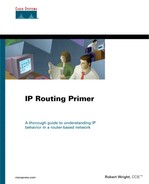Using Floating Static Routes
Floating static routes are static routes that are always in the configuration of a router but are only installed in a routing table when a dynamic route to the same network is lost. The dynamic route overrides the static route because the static route is configured with a greater distance. The concept of distance was introduced in the section on metrics and distances in Chapter 2.
This type of static route can be used when the alternative link is a dial-up connection. Dynamic routing information is not usually sent or received over a dial-up link unless the link is intended to be up for a long period of time. Remember that dynamic routing protocols send updates at regular intervals, causing the link to go up and down on a regular basis.
This scenario provides a real-life example of a floating static route being installed in a routing table after the lower-cost (shorter-path or lower-metric) routes are removed.
In Figure 5-23, the link between RouterA and RouterC is now an ISDN connection. This link is used when the primary link between RouterA and RouterB goes down.
Figure 5-23. RouterA and RouterC have an ISDN connection.

The following partial configuration from RouterA shows how to configure a floating static route. The 130 is the distance parameter. It overrides the distance of 120 that RIP uses.
RouterA#
!
ip route 10.0.0.0 255.0.0.0 168.71.9.2 130
ip route 0.0.0.0 255.0.0.0 168.71.9.2 130
!
In the following routing table from RouterA, you can see that RouterA has installed dynamic RIP routes for networks 10.0.0.0 and 0.0.0.0 via RouterB:
RouterA#show ip route
Codes: C - connected, S - static, I - IGRP, R - RIP, M - mobile, B - BGP
D - EIGRP, EX - EIGRP external, O - OSPF, IA - OSPF inter area
E1 - OSPF external type 1, E2 - OSPF external type 2, E - EGP
i - IS-IS, L1 - IS-IS level-1, L2 - IS-IS level-2, * - candidate default
Gateway of last resort is 168.71.6.2 to network 0.0.0.0
R 10.0.0.0 [120/1] via 168.71.6.2, 00:00:00, Serial0
168.71.0.0 255.255.255.0 is subnetted, 3 subnets
C 168.71.9.0 is directly connected, BRI01
C 168.71.6.0 is directly connected, Serial0
C 168.71.5.0 is directly connected, Ethernet0
R* 0.0.0.0 0.0.0.0 [120/1] via 168.71.6.2, 00:00:01, Serial0
RouterA#
In the following routing table from RouterA, you can see that RouterA has not received an update for networks 10.0.0.0 and 0.0.0.0 for almost two minutes. These routes will timeout soon.
RouterA#show ip route
Codes: C - connected, S - static, I - IGRP, R - RIP, M - mobile, B - BGP
D - EIGRP, EX - EIGRP external, O - OSPF, IA - OSPF inter area
E1 - OSPF external type 1, E2 - OSPF external type 2, E - EGP
i - IS-IS, L1 - IS-IS level-1, L2 - IS-IS level-2, * - candidate default
Gateway of last resort is 168.71.6.2 to network 0.0.0.0
R 10.0.0.0 [120/1] via 168.71.6.2, 00:01:58, Serial0
168.71.0.0 255.255.255.0 is subnetted, 3 subnets
C 168.71.9.0 is directly connected, BRI0
C 168.71.6.0 is directly connected, Serial0
C 168.71.5.0 is directly connected, Ethernet0
R* 0.0.0.0 0.0.0.0 [120/1] via 168.71.6.2, 00:01:59, Serial0
RouterA#
In the following output of the debug ip routing command from RouterA, you can see the old routes being removed and the new ones being accepted. Note the higher distances (130) in the new routes.
RouterA#debug ip routing
*Feb 1 03:53:51: RT: flushed route to 0.0.0.0 via 168.71.6.2 (Serial0)
*Feb 1 03:53:51: RT: no routes to 0.0.0.0, entering holddown
*Feb 1 03:53:51: RT: flushed route to 10.0.0.0 via 168.71.6.2 (Serial0)
*Feb 1 03:53:51: RT: no routes to 10.0.0.0, entering holddown
*Feb 1 03:53:51: RT: flushed route to 168.71.7.0 via 168.71.6.2 (Serial0)
RouterA#
*Feb 1 03:54:45: RT: garbage collecting entry for 0.0.0.0
*Feb 1 03:54:45: RT: garbage collecting entry for 10.0.0.0
*Feb 1 03:55:13: RT: add 0.0.0.0 0.0.0.0 via 168.71.9.2, static metric [130/0]
*Feb 1 03:55:13: RT: add 10.0.0.0 255.0.0.0 via 168.71.9.2, static metric [130/0]
*Feb 1 03:55:13: RT: default path is now 0.0.0.0 via 168.71.9.2
*Feb 1 03:55:13: RT: new default network 0.0.0.0
In the following routing table from RouterA, you can see the new routes installed:
RouterA#show ip route
Codes: C - connected, S - static, I - IGRP, R - RIP, M - mobile, B - BGP
D - EIGRP, EX - EIGRP external, O - OSPF, IA - OSPF inter area
E1 - OSPF external type 1, E2 - OSPF external type 2, E - EGP
i - IS-IS, L1 - IS-IS level-1, L2 - IS-IS level-2, * - candidate default
Gateway of last resort is 168.71.9.2 to network 0.0.0.0
S 10.0.0.0 [130/0] via 168.71.9.2
168.71.0.0 255.255.255.0 is subnetted, 3 subnets
C 168.71.9.0 is directly connected, Serial1
C 168.71.6.0 is directly connected, Serial0
C 168.71.5.0 is directly connected, Ethernet0
S* 0.0.0.0 0.0.0.0 [130/0] via 168.71.9.2
RouterA#
The dial-on-demand routing (DDR) commands necessary to actually cause RouterA to make an ISDN call to RouterC have not been included. DDR is beyond the scope of this book. The key factor needed for DDR to work is that the router must decide that the dial-up interface is the correct interface to use for forwarding a packet to its next hop.
In this scenario, RouterA has just installed routes that will cause it to forward packets destined to 10.1.0.0 via its ISDN interface. Assuming that the DDR commands are properly configured, the call should be made and a connection should be established.
